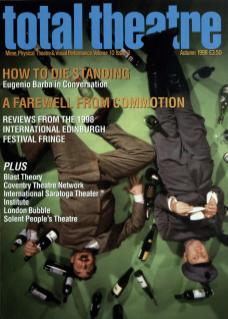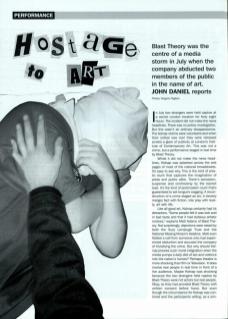In July two strangers were held captive at a secret London location for 48 hours. The incident did not make the news headlines. There was no police investigation. But this wasn't an ordinary disappearance. The kidnap victims were volunteers and when their ordeal was over they were released amidst a glare of publicity at London's Institute of Contemporary Art. This was not a crime, but a performance staged in real time by Blast Theory.
Whilst it did not make the news headlines, Kidnap was splashed across the arts pages of most of the national broadsheets. It's easy to see why. This is the kind of artistic stunt that captures the imagination of press and public alike. There's sensation, suspense and controversy by the bucket load. It's the kind of postmodern stunt that's guaranteed to set tongue's wagging. A reconstruction of a crime staged as art, it cleverly merges fact with fiction, role play with reality, art with life.
Like all good art, Kidnap certainly had its detractors. ‘Some people felt it was sick and in bad taste and that it had dubious artistic motives,’ explains Matt Adams of Blast Theory. Not surprisingly, objections were raised by both the Suzy Lamplugh Trust and the National Missing Person's Helpline. Matt even fielded a call from someone who had experienced abduction and accused the company of trivialising the crime. But why should Kidnap provoke such moral indignation when the media pumps a daily diet of sex and violence into the nation's homes? Perhaps theatre is more shocking than film or television. It does involve real people in real time in front of a live audience. Maybe Kidnap was shocking because the two strangers held captive by Blast Theory were not actors but real people. Okay, so they had provided Blast Theory with written consent beforehand. But even though the circumstance for Kidnap was contrived and the participants willing, as a simulation of a real kidnap scenario this is arguably as close as it's possible to get.
So why volunteer to be a hostage to art? Victim number one, Debra Burgess, is currently on a working holiday from Australia. She explains: ‘Part of the reason I'm over here is to challenge my horizons and my comfort zone.’ Being bundled into a van with a bag over your head and driven to a secret location to be locked in solitary confinement for twenty hours, is certainly one way of doing that. Victim number two, nineteen year old Russell Ward, is less philosophical about his motivation for signing up. ‘It seemed like a really mental idea,’ he says. He also thought this might be his chance to grab fifteen minutes of fame – ‘maybe I'd get on TV’.
Neither victim knew where they were being held, what their kidnappers looked like (they wore bags over their heads whenever a member of the company was in the room), what time of day it was, or when they'd be fed. They could only be certain that they would be released at a designated time and that they were unlikely to be harmed. Debra's instant reaction to being kidnapped was to laugh and Russell describes an initial sense of pleasure at surrendering control. But both victims soon realised that 48 hours of controlled captivity is a long time. Debra admits that she started to ‘get the shakes’ as soon as she realised she had ‘completely given the next three days of my life to total strangers’.
If losing control is stressful, being in control is also a strain as Blast Theory were to discover. Although Debra and Russell were central to the performance, they were also along for the ride – Blast Theory were in the driving seat. Kidnap was the result of months of meticulous planning. The company placed ten individuals under surveillance, with four members working full-time over a three-week period to track them down. This process of entrapment was no more or less real than that undertaken by police on a stake-out. Blast Theory employed the same tactics, as Matt explains: ‘The process was about being surreptitious in every single respect.’ Thus the kidnappers spent days holed-up in a van, with newspaper masking the windows, peering through tiny cracks for a glimpse of their target. Some of the ten were easy to track down, some never materialised, and some gave Blast Theory a run for their money. When the time came to abduct Russell Ward, the scenario could have been lifted straight from a TV cop show. In an elaborate game of cat and mouse, there was a car chase through the streets of Southend in the middle of the night and Russell was only caught when Blast Theory eventually recruited one of his friends to trick him out of his house and into a waiting car, where one of the kidnappers was concealed in the boot. Result.
This all sounds like fun. And Matt admits that ‘there was a kind of tacit agreement between the kidnappers and the kidnappees that this was all a big joke’. But he goes on to point out that ‘the reality of the situation felt much more tangible and direct than we'd imagined’. For a start, for the three days in which Russell and Debra were incarcerated, Blast Theory had to behave like kidnappers. This meant not being too nice so the experience might feel like a short trip to a holiday camp. But not being too nasty either. Blast Theory didn't want to mentally scar their volunteers, and even went as far as having a trained psychologist permanently on-site throughout the ‘performance'.
But they did have to find ways of asserting their control. Obviously they held the reigns. Russell and Debra were kept securely locked in a three metre square box and under constant surveillance from two video cameras. As Debra attests: ‘We never talked about trying to escape because it was painfully obvious why that wasn't going to happen: we could hear how many locks were on the door.’ But either of them could have uttered a pre-agreed password to secure their release. The success of the project relied upon a curious complicity between the kidnappers and kidnappees. It was a game of control, which was at once real and imagined. Both sides had to play the game. And both sides did. But why?
Clearly Debra and Russell weren't in it for the art. They signed up to participate in Kidnap for much the same reason as people get their tongues pierced or go bungee jumping. It's out of the ordinary and certainly disrupts the tedium of daily routine. Russell admits the lure of Kidnap was irresistible: ‘I thought, if I don't do this I could really regret it. It could either be an incredible experience I'd never forget, or something I'd hate and wish I'd never done.’ Debra goes further when she claims, 'It's been probably one of the most amazing things I'll ever do or be a part of.’ Clearly the experience has had a lasting effect on both of them, not least because they got to be the centre of attention in a high profile performance art event that even attracted a feature in The Sunday Times.
Blast Theory weren't surprised by the quantity of press attention the project attracted, although they were pleasantly pleased by the overall quality of the debate it provoked. Matt Adams bristles at the suggestion that Kidnap might have been conceived as a cynical exercise in media manipulation. But he does concede that the last few months have been a sharp learning curve for the company and that, as a result of Kidnap, future Blast Theory projects might ‘deal with the media in a more full-bloodied fashion’. Quite what he means by this is anyone's guess at this stage but Kidnap will undoubtedly be a hard act to follow, as Matt is only too aware: ‘It's such a pure and simple idea... in a way, we need to avoid doing anything like it again, until we can somehow find something that's similarly elegant.’


